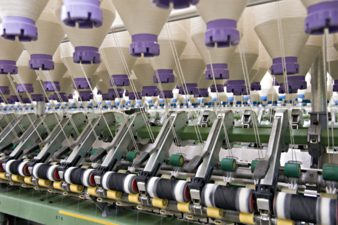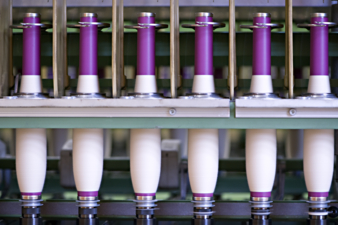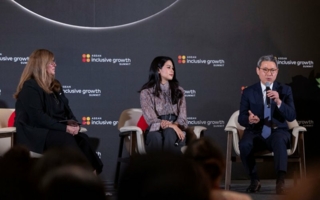18/05/2016 – Buhler Quality Yarns — auf Deutsch lesen
Market leader takes new path
Buhler Quality Yarns is a key supplier to the knit trade in the Western Hemisphere.
A division of Swiss-based Buhler, the operation in Jefferson, Ga., opened in 1996. Buhler has about 32,000 spindles and produces about 3,700 tons of yarn annually.
The Georgia-based plant specialises in yarns made from Supima extra-long staple cotton, MicroModal Edelweiss and Micro Tencel, along with various blends. The company is considered to be the leading producer of fine-count yarns in the US.
David Sasso, vice president of sales at Buhler Quality Yarns, reports that business has been good in 2015 and he says he’s optimistic the year will finish that way and continue into the next. However, customers’ habits have changed in recent years. In the past, Buhler could count on long programme orders. Now, it is more of a short order situation. While business is steady, there is less certainty these days.
Through the years, Buhler Quality Yarns has evolved from being a traditional sales yarn spinner to becoming involved in supply chain management, creating retail relationships and developing an understanding of the supply chain and how the spinner can participate. “We have an understanding of all the costs involved between the fibre and garment stage and that’s not typically what a spinner does,” Sasso says.
About 90 percent of Buhler’s yarn production goes into the knit trade. Orders from Central America are strong, likewise with Peru. Sasso describes the US domestic market as steady.” Buhler is relying on export markets for long-term programmes. The largest end use for Buhler yarn is knitted apparel. Some also goes into uniforms and military garments. Sasso notes that while apparel more often represents short-term programmes, there is an opportunity in the high-end sheeting market.
Buhler also produces yarn for woven applications, such as the military and some for towel manufacturing. “Our parent company produces air-jet and ring-spun yarns,” Sasso says. “We use them to see how that market goes and to see what the demand for those yarns is. We keep a close eye on those technologies and if we can implement them here, we will.”
Yarn spinners face a myriad of challenges, but weather is not usually at the top of the list. However, the ongoing drought in California continues to affect pima cotton. Buhler sources all of its Pima from California.
“We’re concerned about raw material prices,” Sasso says, “So, you have to have alternatives because it affects pricing.”
Sasso has been with Buhler’s US operation since 2001. He says the biggest change in the industry during those years has been the explosion of online retailing and buying. He notes that the more choices consumers have, the more unpredictability there is in the market.
Developing close relationships along the supply chain can often bring in unexpected business. “The traditional way of thinking about selling yarns is not very effective any more,” Sasso says. “Our knit customers or our garment customers, all of these guys can sell and pull your yarns through.”
Most of Buhler’s orders come from long-standing customers. The company is well known in the industry, among brands and retailers: “If I visit a brand in Los Angeles, I want to make sure what we are the preferred yarn supplier for their apparel. Everyone knows you need high-end yarns and Buhler is the supplier of choice.”
Much of the recent investment in the US textile industry has involved yarn spinning in the South. Sasso says the relatively low energy costs in the region have encouraged expansion. Lower energy costs help offset higher labour costs. Buhler has not had a major expansion, but has replaced three of its older spinning machines with new models, which has increased its capacity. While some areas of the South have seen a dissipation of qualified textile employees over the past 15 years as the overall industry has shrunk, Sasso says Buhler has been successful in maintaining a qualified work force.
Employment at Buhler has remained fairly steady in recent years, averaging about 150, including management. Sasso observes that today’s textile workers have to be a combination of electrician and mechanical engineer. “While spinning hasn’t changed in many years, the environment they work in is so much better than it was.”
Author: John McCurry





